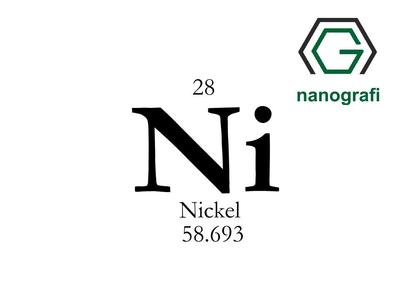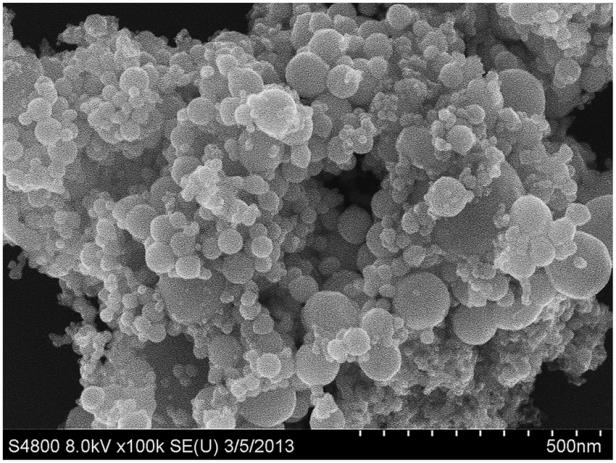General Information about Nickel

Nickel is a chemical element with symbol Ni and atomic number 28. It is a silvery-white lustrous metal with a slight golden tinge. Nickel belongs to the transition metals and is hard and ductile. Pure nickel, powdered to maximize the reactive surface area, shows a significant chemical activity, but larger pieces are slow to react with air under standard conditions because an oxide layer forms on the surface and prevents further corrosion.
Applications and Usage Areas of Nickel Nanoparticles/Nanopowder

Nickel Nanoparticles/Nanopowder have large surface area and high activity. Due to these properties Nickel Nanoparticles/Nanopowder are very efficient catalysts for different types of chemical reactions like hydrogenation and waste management of harmful chemicals. Nickel nanoparticles/nanopowder are used as solid propellants which increase combustion heat, combustion efficiency and combustion stability. Nickel nanoparticles/nanopowder give excellent properties to magnetic fluids. When Nickel nanoparticles/nanopowder are used as an additives, they can effectively reduce sintering temperatures of metals and ceramics.
We have Nickel nanoparticles/nanopowder in different sizes that will meet your needs. You may see their properties below.
Technical Properties of Our Nickel (Ni) Nanoparticles/Nanopowder 99.95%, 18 nm, carbon coated Product
| Ni Purity (%): | ≥99.9 |
| True Density (g/cm3): | 8,9 |
| Shape: | spherical |
| Color: | black |
| AVERAGE PARTICLE SIZE (nm): | 20 |
| SPECIFIC SURFACE AREA (m2/g): | 45,0-70,0 |
You may buy Nickel (Ni) Nanoparticles/Nanopowder 99.95%, 18 nm, carbon coated from the link given below:
Technical Properties of Our Nickel (Ni) Nanoparticles/Nanopowder 99.95%, 18 nm, partially passivated Product
| Ni Purity (%): | ≥99.9 |
| True Density (g/cm3): | 8,9 |
| Shape: | spherical |
| Color: | black |
| AVERAGE PARTICLE SIZE (nm): | 20 |
| SPECIFIC SURFACE AREA (m2/g): | 45,0-70,0 |
You may give an order of Nickel (Ni) Nanoparticles/Nanopowder 99.95%, 18 nm, partially passivated from the link given below:
Technical Properties of Our Nickel (Ni) Nanoparticles/Nanopowder, 99.95%, 65 nm, metal basis Product
| True Density (g/cm3): | 8,9 |
| Shape: | spherical |
| Color: | black |
| AVERAGE PARTICLE SIZE (nm): | 65 |
| SPECIFIC SURFACE AREA (m2/g): | 10,0-16,0 |
You may give an order of Nickel (Ni) Nanoparticles/Nanopowder, 99.95%, 65 nm, metal basis from the link given below:
Technical Properties of Our Nickel (Ni) Nanoparticles/Nanopowder, 99.95%, 90 nm, metal basis Product
| Bulk Density (g/cm3): | 1,1 |
| True Density (g/cm3): | 8,9 |
| Shape: | spherical |
| Color: | black |
| AVERAGE PARTICLE SIZE (nm): | 90 |
| SPECIFIC SURFACE AREA (m2/g): | 28,1 |
You may give an order of Nickel (Ni) Nanoparticles/Nanopowder, 99.95%, 90 nm, metal basis from the link given below:
Technical Properties of Our Nickel (Ni) Nanoparticles/Nanopowder 99.95%, 790 nm, metal basis Product
| True Density (g/cm3): | 8,9 |
| Color: | dark grey |
| Crystal Structure: | cubic |
| Tmelting (oC): | 1455 |
| Tboiling (oC): | 2730 |
| AVERAGE PARTICLE SIZE (nm): | 800 |
You may give an order of Nickel (Ni) Nanoparticles/Nanopowder 99.95%, 790 nm, metal basis from the link given below:
Technical Properties of Our Nickel (Ni) Nanoparticles/Nanopowder 99.95%, 31 nm, metal basis Product
| True Density (g/cm3): | 8,9 |
| Shape: | spherical |
| Color: | black |
| AVERAGE PARTICLE SIZE (nm): | 40 |
| SPECIFIC SURFACE AREA (m2/g): | 11,0-15,0 |
You may give an order of Nickel (Ni) Nanoparticles/Nanopowder 99.95%, 31 nm, metal basis from the link given below:
Comments
Post a Comment